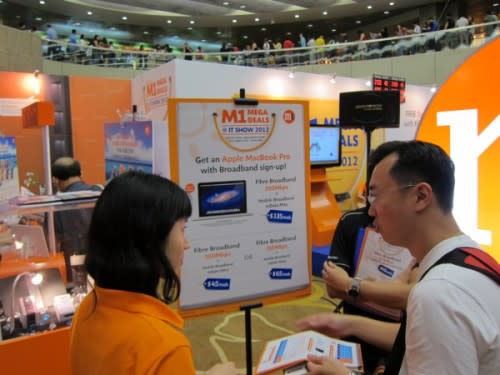Fibre broadband prices slashed at new price war at IT Show

The rapidly heating up broadband wars in Singapore crossed an important mark this week, when the Big Three telcos all dropped prices for the benchmark 100Mbps service under S$50 a month.
SingTel, StarHub and M1 began a new phase of competition at the IT Show running at Suntec City, hoping to lock in as many subscribers as possible as the country’s next-gen fibre network nears completion in June this year.
Since last year, M1 had been “spoiling” the market at each quarterly tech bazaar by slashing prices for 100Mbps services to as low as S$39 a month. This weekend, it is offering 100Mbps at S$45, but still some way off its usual S$59, and keeping it competitive against its two bigger rivals.
This time round, however, SingTel and StarHub have decided to follow suit and slash prices aggressively. SingTel is selling its 100Mbps service for S$49.90. StarHub’s offer is S$49.65.
This signals a major shift in the market, as telcos begin to see the importance of locking users to two-year contracts as more of them come onboard with the expansion of the fibre network rollout throughout the island.
SingTel had kept its prices higher than M1’s for months since the first services went online last year, but it appears to have tired from simply bundling its mio TV services as part of a more expensive package and decided to jump in the fray.
StarHub, too, after months of trying to sell its older cable modem services as superior in terms of international bandwidth, has joined the price war to push its fibre services. The alternative, after all, is clear: loss of customers for at least two years if they switch to the cheaper M1 service.
Two smaller players, MyRepublic and ViewQwest, are sticking to their prices and dangling no-contract try-outs, but they are likely to find it harder to slash prices at will to gain share, as the bigger players do.
The reason: they do not have accompanying mobile services and TV content to up-sell to a growing group of fibre broadband users. They also don’t have pockets as deep as the Big Three.
The biggest winner of this latest round of the price war, obviously, is the consumer. Just a year ago, about $50 can buy them only 16Mbs of bandwidth. Today, they get more than five times that while paying less.
Will these prices hold? It seems that telcos are trying to keep them going only at quarterly tech bazaars, for now. But with most things technology, it is always harder to raise than drop prices.
Would they be sustainable in the long term? For the big players, this is not in question. The equipment used to provide the fibre broadband service will get cheaper over the years – the same way PCs become cheaper – so their costs will come down and make the business profitable as more users sign up in future.
Thus, this big change in the market is clearly a positive that has emerged from the billion dollars that the Singapore government had sunk into the building of the fibre network.
Though the telcos say the price drops are only valid this weekend, the changes are long-term and real. Prices will continue to drop or at least hold, bringing Singapore finally on par with places like Hong Kong and South Korea, where broadband prices had always been faster and cheaper in the past.


